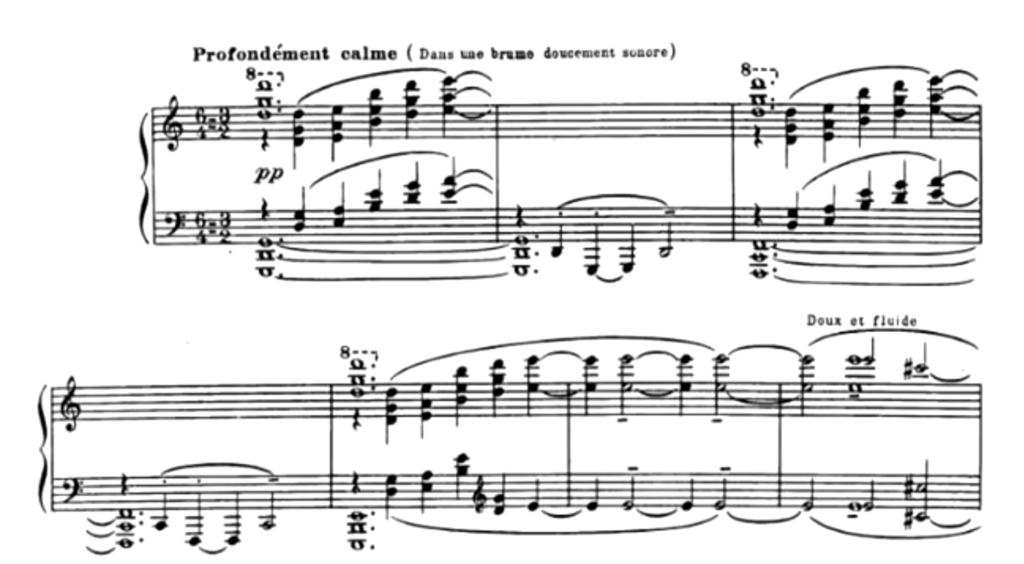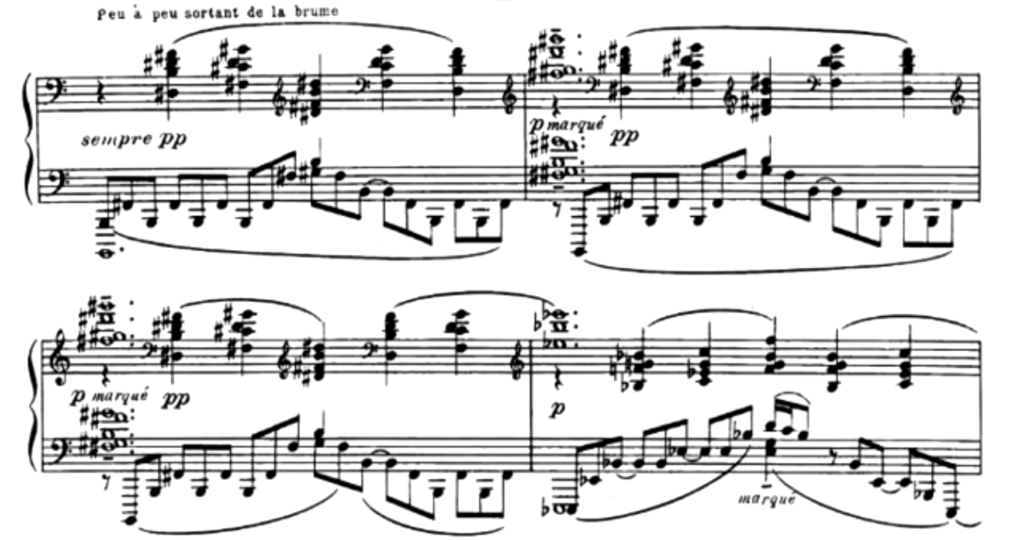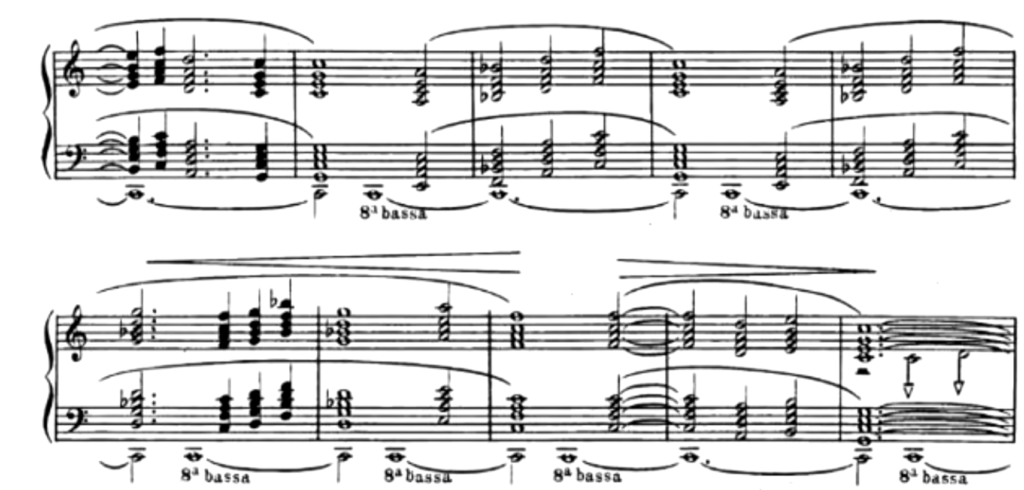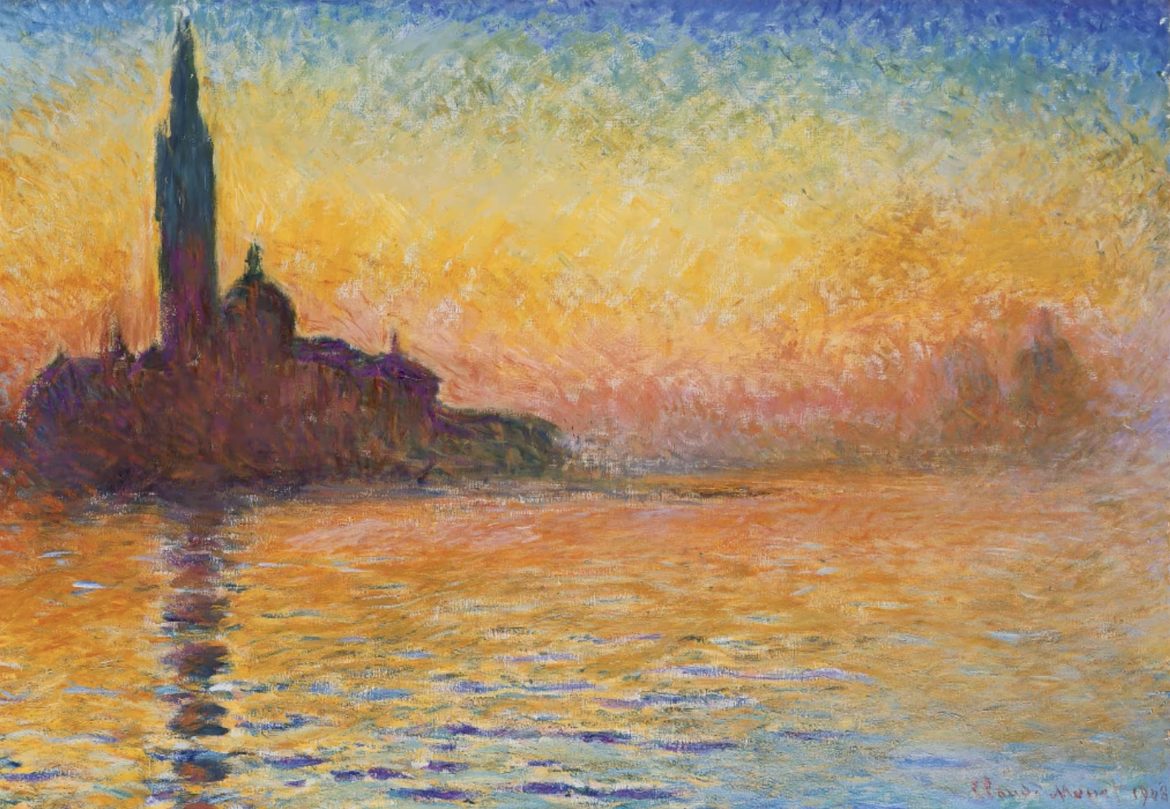德布西的《沉沒的教堂》由他對神秘與超自然的迷戀所啟發,讓我們進入了一個沉寂在海底的古老教堂,聽見遠處的鐘聲在海洋的壓力下變得模糊而神秘。本文我們將深入探索這首作品的創作背景和音樂分析,並嘗試理解德布西是如何將這種視覺影像轉化為音樂語言的。
沉沒的教堂 靈感來源
這首曲子是德布西鋼琴前奏曲集中的一部分,於1910年完成。這首作品的靈感來源於布列塔尼地區的一個古老傳說,該傳說描述了一座名為伊西(Ys)的古老城市沉入海底,只有在清晨,人們才能在海面上看見教堂的尖頂。當潮水退去時,神秘的鐘聲會從海底傳出,彷彿在提醒人們這座被遺忘的城市的存在。
布列塔尼
布列塔尼(Brittany)是法國的一個半島,位於法國的西北部,擁有豐富的自然景觀和深厚的文化傳統。它是法國最大的半島,被大西洋包圍,有許多美麗的海岸線和海灘。
這裡的居民稱為布列塔尼人,他們有自己的語言——布列塔尼語,與獨特的文化,雖然如今使用的人數已經減少,但仍然被認為是這個地區的重要部分。這裡的史前遺址非常有名,有許多的巨石陣和古老的墓穴。在中世紀,布列塔尼曾是一個獨立的公國,後來在15世紀時成為法國的一部分。民間傳說也非常豐富多彩,其中許多傳說都與海洋有關,反映了這個區域與海洋的密切聯繫,其中最知名的就是伊西(Ys)的傳說,講述了一座被海水淹沒的城市和它的驕縱公主達哈特。
在音樂方面,布列塔尼也有自己的傳統音樂,包括民謠和舞曲,常常在當地的節慶活動中被演奏。德布西的《沉沒的教堂》就是受到了布列塔尼的傳統音樂和民間傳說的啟發,創作出這首充滿神秘和夢幻氛圍的作品。
伊西的傳說
伊西(Ys)是一個存在於布列塔尼民間傳說中的古城。這座城市由布列塔尼的國王格拉達隆(Gradlon)為他的愛女達哈特(Dahut)所建。
達哈特公主既美艷又驕縱,沉迷於奢華的生活和珍寶,尤其是她的愛馬的金色鞍具。為了得到這些鞍具,達哈特誘騙了一名叫做旺塔爾(Kanteg)的男子,讓他把保護城市不被海水淹沒的魔法鑰匙交給她。然而,在一次狂歡的派對中,達哈特酒醉意亂,忘記了海潮的危險,導致海水淹沒了伊西城。
當伊西城即將滅亡時,格拉達隆王向聖科里安(Saint Corentin)求助,他是伊西的守護聖人。科里安派騎士聖吉諾萊(Saint Guénolé)前去營救。聖吉諾萊成功地救出了國王,但當他返回試圖救出達哈特時,達哈特卻被魔鬼拖入海中,因為她已將自己的靈魂賣給了魔鬼。自此,伊西城沉入海底,成為了一座沉睡的城市。
然而,傳說認為,當你在清晨靠近海邊,特別是在寧靜的時刻,你可以聽到來自海底的伊西城的鐘聲和教堂的唱詩,這是這座古城繁華生活的回聲。這個傳說激發了德布西創作出《沉沒的教堂》,試圖透過音樂捕捉這種神秘而夢幻的氛圍,並讓這個古老的傳說在我們的心中生息。
關於教堂
在伊西(Ys)的傳說中,沉沒的城市被描述成極度奢華且富麗堂皇,教堂自然不例外。教堂的象徵意義並不只在於其物理存在,更在於它代表的信仰和精神。在這個傳說中,教堂象徵著神聖和純潔,與達哈特公主的放縱和混亂形成鮮明對比。
然而,這座教堂在傳說中並沒有被特別詳細地描繪出來,它的形象主要來自聽眾的想像。在德布西的《沉沒的教堂》中,鐘聲的音樂主題就讓人們聯想到教堂的存在,讓人們對這座沉沒的教堂有了更深刻的感受。
德布西與象徵主義
德布西,這位偉大的法國作曲家,於1862年出生於法國的聖日耳曼昂萊。他的音樂天賦在很早就被他的家人所發現,並在他的教育過程中得到了鼓勵。他在巴黎音樂學院接受了正規的音樂教育,並在那裡接觸到了當時的音樂風潮和思潮。
通感
象徵主義這種藝術運動對德布西的音樂風格產生了深遠的影響。這種運動強調「通感」:一種跨越感官界限的經驗,讓人們通過文字或音樂,可以看見顏色,嗅到氣味,甚至看到畫面。這種運動鼓勵創作者通過象徵和隱喻,將觀眾帶入一個超越現實的世界,體驗精神和情感的旅程。
“通感”這個詞語在英文中通常被翻譯為 “synesthesia”,在法文中則是 “synesthésie”。這個詞語源於兩個古希臘詞語,”syn” 意為 “一起”,”aisthesis” 則是 “感覺”。因此,”synesthesia” 或 “synesthésie” 這個詞的字面意思就是 “共感” 或 “聯合感覺”,用來形容一種感官經驗,其中一種感官的刺激能引起另一種感官的體驗。在神經科學中,通感被認為是一種神經現象,其中一種感覺或認知路徑會引發另一種感覺或認知路徑的體驗。在藝術和文學中,通感更多地被用來形容一種藝術技巧,創作者利用這種技巧來激發觀眾或讀者的多感官體驗,增強他們對作品的感知和感受。
在德布西的音樂中,他就使用了這種通感的藝術手法,他的音樂作品試圖創造一種視覺和聽覺的交織體驗,讓聽者在聽音樂的同時,也能在腦海中看到顏色和形狀,從而更深入地感受到音樂的氛圍和情感。
具象
德布西和他的同時代的作曲家拉威爾,都是象徵主義音樂的重要代表,不僅斷裂了法國音樂與主流的德國音樂的聯繫,也開闢了一種全新的音樂路徑。他們的作品,特別是德布西的《沉沒的教堂》和拉威爾的《達夫尼斯與克洛伊》等,都以具象的主題為基礎,強調音樂的「效果」,透過音樂創造出引人入勝的畫面,激發聽眾的想像力。相比之下,當時的德國音樂,如理查·史特勞斯和古斯塔夫·馬勒的作品,更加強調結構、曲式和音樂邏輯。
德布西的音樂,與其說是為了表現某種具體的情緒或故事,不如說是為了創造一種音樂的氛圍,一種能夠引發聽眾想像力的音樂。他的音樂是一種對現實世界的超然與逃避,是一種對理想世界的嚮往和追求。這種音樂風格和創作理念,使得德布西成為了印象派音樂的代表人物。他的作品中,音樂並不是用來敘述故事,而是用來描述一種感覺,一種氛圍,一種印象。就像印象派畫家用筆觸來捕捉光線和色彩的變化,德布西用音符和節奏來描繪音樂的情感和氛圍。
音樂分析
1-5小節
開頭以寬闊的音程展開,左右手的寬範圍運動創造出海洋的廣闊感。德布西在此處刻意弱化傳統三和弦的功能性,採用了大量平行的五度與四度,帶有中世紀聖歌與奧干農(organum)的色彩。這樣的聲響同時暗示了海浪起伏與古老教堂的莊嚴氛圍,讓人進入了一個古老而神秘的時空,加強了作品的視覺性和敘事性。

6-13小節
鐘聲主題首次出現,以八度重疊的方式呈現,簡單卻共鳴深遠,營造出深邃而神秘的氛圍。這種音響或許與德布西在 1889 年巴黎世博聽到的印尼 Gamelan 音樂經驗相關,帶來特殊的音色靈感,彷彿我們聽到了沉睡在海底的古老教堂的鐘聲。

16-21小節
在這段音樂中,主旋律以更廣闊的音域和更強烈的力度呈現,象徵著海底的教堂在海浪的推動下,慢慢地升起至海面。德布西在此處巧妙地使用了各種不同的音樂手法,例如和聲的增加,來描繪這種壯觀而神秘的景象。旋律以其特有的模糊感和自由度,強調了這個過程的不確定性和超自然的氛圍。
低音在這裡使用了非常獨特的節奏,既有規律的四分音符,也有不規則的三連音。這種節奏的變化使得音樂聽起來有一種起伏不定、波濤洶湧的感覺,仿佛是大海的波浪在推動著教堂的升起。這樣的節奏處理,增加了音樂的動態效果,讓人感覺到教堂在海浪中的起伏動盪。

22-27小節
德布西使用了堆疊式的和弦,這些塊狀的和弦彼此之間保持著一定的距離,從而營造出一種遼闊、神秘的氛圍。德布西使用了平行和弦移動的手法,進一步強化了印象派音樂的特色。左手的連續音符線條模仿了鐘聲的迴盪。

28-39小節
音樂達到了高潮,音量和動態都達到了頂點,代表著教堂完全出現在海面上的壯觀景象,大聲的超級低音,就像大力的敲打教堂的鐘,鐘聲響徹雲霄,所有和弦皆是很壯麗的大和弦。

47-52小節
音樂進入了教堂的內部。這裡的Pedal point技巧模仿了風琴的演奏,使音樂營造出一種神秘而寧靜的氛圍。旋律部分如同僧侶在歌唱,以教會調式(Church mode)編寫,而這種調式常見於中世紀的葛雷果聖歌(Gregorian chant),讓人感受到沉默的教堂內部所蘊含的宗教氛圍。

70-結尾
德布西將最初的主題經過短暫的過渡再次呈現,但這出現在低音部分,並以低迴的形式出現。這種變化使得音樂與之前的海浪拍岸表象世界有所不同,繼續保持了整首曲子神秘、遼闊的氛圍。
隨著曲子接近尾聲,動態逐漸減弱。這種變化使音樂呈現出一種平靜、沉思的氛圍,彷彿教堂逐漸消失在遠方。德布西呈現出一種淡化的、回聲般的效果,音樂在柔和的和弦之間逐漸消失。結尾保持了作品的統一性,又增強了沉默教堂神秘、寧靜的意象。

Youtube Listening
非常謝謝你的閱讀,這裡是RosyArts。
看更多相關文章?歡迎到RosyArts古典音樂專屬頁面:連結
樂譜:https://musescore.com/user/33306646/scores/6305197
延伸閱讀:
德布西『Estampes 版畫』- 塔、格拉納達的黃昏、雨中花園,3種異國風情的遊歷 | Debussy
德布西《映像 Images》第一冊&第二冊&管弦樂映像全解析|水之倒影、伊貝利亞、金魚


